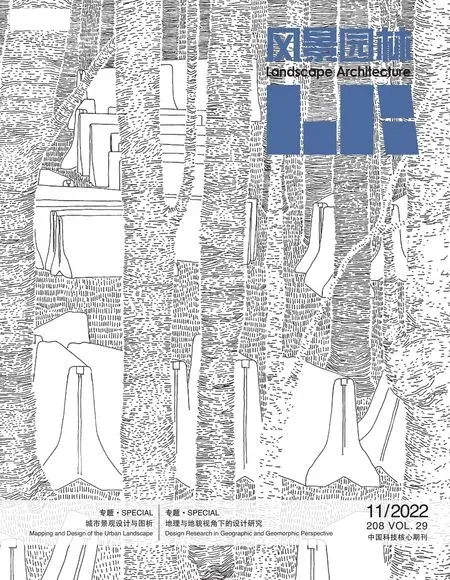地理地貌的设计研究
李宾
20世纪初,苏格兰地理学者帕特里克·盖迪斯提出了《山谷剖面》,借由一种地理剖面图理解人地关系。这一视角关联了从区域至局域地貌、高山到大海的变化,景观空间的多样面貌,人们日常的生产生活景观,形成了跨尺度的连续景观阅读。以地理地貌视角阅读景观也可追溯到徐霞客、亚历山大·冯·洪堡、段义孚、冈瑟·沃格特等众多中外学者,他们的著述与绘述展现了不同地理区域中关联的地貌景观构成。正如,当洪堡站在安第斯山脉钦博拉索山口海拔5 700 m高处,他发现地貌与阿尔卑斯的高山区如此相像,地衣则提示着他曾经考察过的北极地区类型,这样的考察过程最终凝结成了《植物地理图解》。
身处人类世地质时代,我们在日常之中——特别是刚刚过去的夏天——体会着全球气候变化,以及城市化大面积扩散在地理地貌之中;而作为回应,当下的风景园林学出现了根植于这一视角的景观设计研究。一方面这些设计研究以特定的地理地貌形态为基础,通过“被设计的”考察法与表达法介入研究,试图打通研究、教学与设计的边界;另一方面,这些地理区域可以被整体的、全球性的解读,其涉及的设计研究理论与方法也许具有跨地域的应用意义或讨论价值。
本期专题“地理与地貌视角下的设计研究”灵感来于山谷剖面,期待以一种关联的全球地理视野探讨人地关系与景观空间。本专题的文章从极地出发,跨越河流,来到城市及近郊的低山与丘陵,到达海岸和岛屿。或许这样的“地理剖面”视角,可以为风景园林学的设计研究与教学实践带来多尺度、多维度、多学科的方法。或许我们也可以以这样的视角阅读、塑造地球上的景观:它是关联的、俯瞰式的、科学观的;同时也是感知的、剖面式的、以人为本的。
In the early 20th century, Scottish geographer Patrick Geddes created “The Valley Section” and used it as a geographical illustration to comprehend the relations between human and land. This perspective connects the territorial and the local landforms from the high mountains to the oceans,their multifaceted landscape spaces and everyday lived and practiced landscapes, and thereby, forming a continuity of multiscalar landscape readings. We may trace landscape readings in geographic and geomorphic perspective back to scholars such as Xu Xiake, Alexander von Humboldt, Yi-Fu Tuan,and Günther Vogt. Their writings (and drawings)unfold a body of landscape construction distributed across geographies. When Humboldt stood on the 5,700 m Chimborazo mountain pass of the Andes, he discovered that the landforms there bear a resemblance to those of the Alps, and the lichens look similar to those in the Arctic region. He condensed these relational findings into the drawing of “The Geography of Plants”.
In the age of Anthropocene, we are experiencing climate change on a daily basis(particularly this summer) and urbanization around the globe largely extending to varied geomorphic landscapes. As the response to the changes, there is a body of emerging landscape architecture design research rooted in geographic perspectives. On one hand, those design research take particular geographies and landforms as the case, and through “designed” fieldwork, observation, and representation, break the barrier among research,teaching and design. On the other hand, those particular geographies can be read as a relational and global whole, and the theories and the methods of design research on those geographies may be valuable to be discussed across each other.
“Design Research in Geographic and Geomorphic Perspective” is inspired by “The Valley Section” and takes a geographic perspective toward discussing human-land relations and landscape spaces. Let's depart from the polar region, travel across the river, walk around the low mountain and the hill in the city and its periphery,and further reach over to the coastline and the island. We may find multiscalar, multidimensional and multidisciplinary methods for Landscape Architecture design research and teaching converged en route. We may also gain landscape perspectives along the journey: it is relational, aerial,scientific and, furthermore, experiential, sectional and humanistic.
——工程地质勘察中,一种做交叉剖面的新方法

